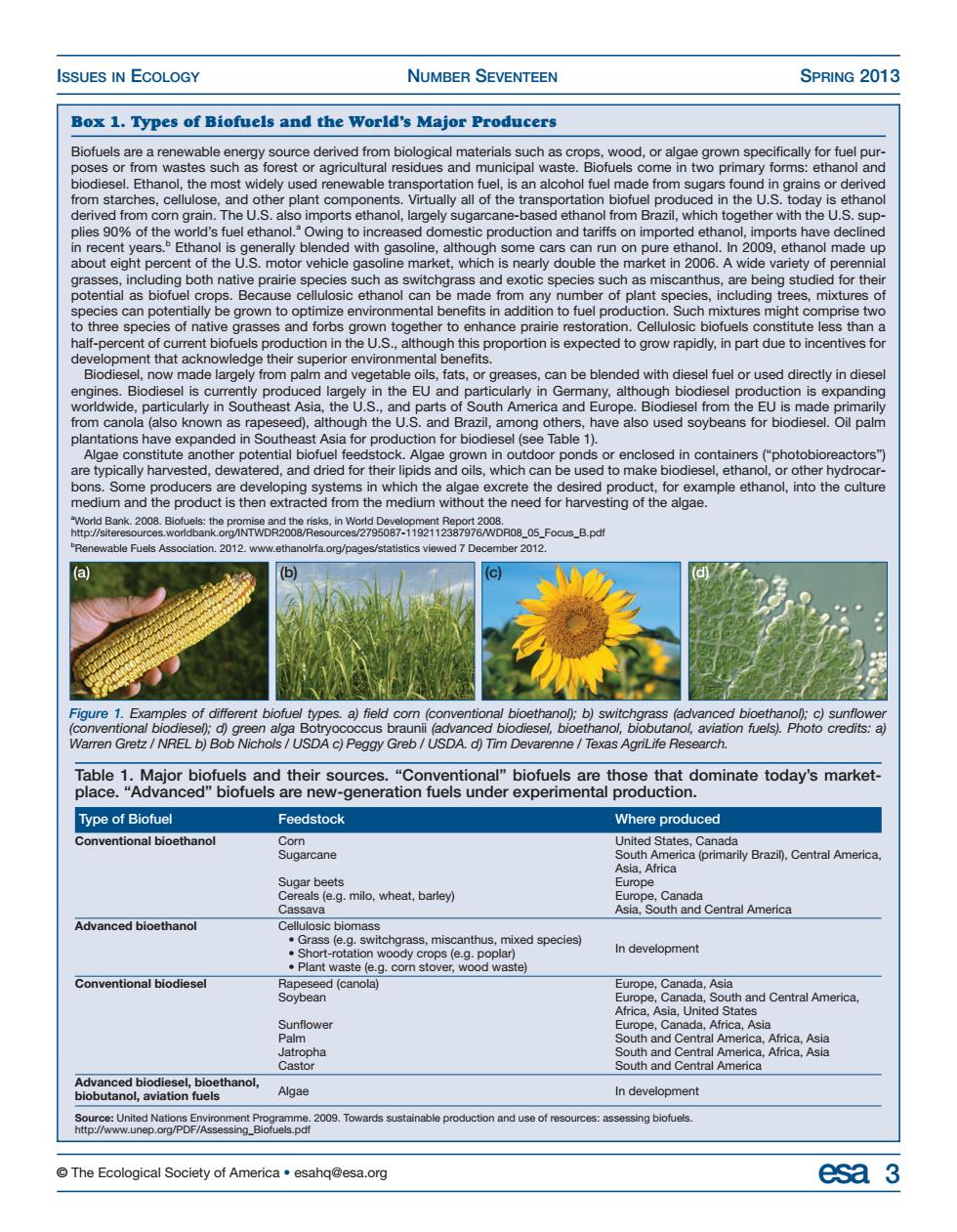正在加载图片...

ISSUES IN ECOLOGY NUMBER SEVENTEEN SPRING 2013 Box 1.Types of Biofuels and the World's Major Producers se an other plant co Virtually all of the nd tariffs on imnorted eth made u e grown to to fuel of nath esepctoneUSaoughthspopotonsepeciedtogowepaihpeidletolne8nineso now made largely from palm and is,fats,or g es,can be blended with diesel fuelor used directly in diese de,partic uth Ameri rop ations hav panded in Southe Asia for production for Tab haMesteggrpotertalboedohepcsandos.whchcantes5edtomaenoaieentheanol.orotmeraoea cally harve H08_05_Focus_B.pd Greh /SDA d Tim De e/Tera fuels are new-generation fuels under experimental production. Type of Biofuel Where produced onal bi frica milo,wheat.barley) Central America Advanced bioethanol sic biomass grass,miscanthus,mixed species) In development Conventional biodiesel d(canola) we anol,Algae In development 2009.Towards s The Ecological Society of America.esahg@esa.ord esa 3© The Ecological Society of America • esahq@esa.org esa 3 ISSUES IN ECOLOGY NUMBER SEVENTEEN SPRING 2013 Box 1. Types of Biofuels and the World’s Major Producers Biofuels are a renewable energy source derived from biological materials such as crops, wood, or algae grown specifically for fuel purposes or from wastes such as forest or agricultural residues and municipal waste. Biofuels come in two primary forms: ethanol and biodiesel. Ethanol, the most widely used renewable transportation fuel, is an alcohol fuel made from sugars found in grains or derived from starches, cellulose, and other plant components. Virtually all of the transportation biofuel produced in the U.S. today is ethanol derived from corn grain. The U.S. also imports ethanol, largely sugarcane-based ethanol from Brazil, which together with the U.S. supplies 90% of the world’s fuel ethanol.a Owing to increased domestic production and tariffs on imported ethanol, imports have declined in recent years.b Ethanol is generally blended with gasoline, although some cars can run on pure ethanol. In 2009, ethanol made up about eight percent of the U.S. motor vehicle gasoline market, which is nearly double the market in 2006. A wide variety of perennial grasses, including both native prairie species such as switchgrass and exotic species such as miscanthus, are being studied for their potential as biofuel crops. Because cellulosic ethanol can be made from any number of plant species, including trees, mixtures of species can potentially be grown to optimize environmental benefits in addition to fuel production. Such mixtures might comprise two to three species of native grasses and forbs grown together to enhance prairie restoration. Cellulosic biofuels constitute less than a half-percent of current biofuels production in the U.S., although this proportion is expected to grow rapidly, in part due to incentives for development that acknowledge their superior environmental benefits. Biodiesel, now made largely from palm and vegetable oils, fats, or greases, can be blended with diesel fuel or used directly in diesel engines. Biodiesel is currently produced largely in the EU and particularly in Germany, although biodiesel production is expanding worldwide, particularly in Southeast Asia, the U.S., and parts of South America and Europe. Biodiesel from the EU is made primarily from canola (also known as rapeseed), although the U.S. and Brazil, among others, have also used soybeans for biodiesel. Oil palm plantations have expanded in Southeast Asia for production for biodiesel (see Table 1). Algae constitute another potential biofuel feedstock. Algae grown in outdoor ponds or enclosed in containers (“photobioreactors”) are typically harvested, dewatered, and dried for their lipids and oils, which can be used to make biodiesel, ethanol, or other hydrocarbons. Some producers are developing systems in which the algae excrete the desired product, for example ethanol, into the culture medium and the product is then extracted from the medium without the need for harvesting of the algae. a World Bank. 2008. Biofuels: the promise and the risks, in World Development Report 2008. http://siteresources.worldbank.org/INTWDR2008/Resources/2795087-1192112387976/WDR08_05_Focus_B.pdf b Renewable Fuels Association. 2012. www.ethanolrfa.org/pages/statistics viewed 7 December 2012. Figure 1. Examples of different biofuel types. a) field corn (conventional bioethanol); b) switchgrass (advanced bioethanol); c) sunflower (conventional biodiesel); d) green alga Botryococcus braunii (advanced biodiesel, bioethanol, biobutanol, aviation fuels). Photo credits: a) Warren Gretz / NREL b) Bob Nichols / USDA c) Peggy Greb / USDA. d) Tim Devarenne / Texas AgriLife Research. Table 1. Major biofuels and their sources. “Conventional” biofuels are those that dominate today’s marketplace. “Advanced” biofuels are new-generation fuels under experimental production. Type of Biofuel Feedstock Where produced Conventional bioethanol Corn United States, Canada Sugarcane South America (primarily Brazil), Central America, Asia, Africa Sugar beets Europe Cereals (e.g. milo, wheat, barley) Europe, Canada Cassava Asia, South and Central America Advanced bioethanol Cellulosic biomass • Grass (e.g. switchgrass, miscanthus, mixed species) In development • Short-rotation woody crops (e.g. poplar) • Plant waste (e.g. corn stover, wood waste) Conventional biodiesel Rapeseed (canola) Europe, Canada, Asia Soybean Europe, Canada, South and Central America, Africa, Asia, United States Sunflower Europe, Canada, Africa, Asia Palm South and Central America, Africa, Asia Jatropha South and Central America, Africa, Asia Castor South and Central America Advanced biodiesel, bioethanol, Algae In development biobutanol, aviation fuels Source: United Nations Environment Programme. 2009. Towards sustainable production and use of resources: assessing biofuels. http://www.unep.org/PDF/Assessing_Biofuels.pdf (a) (b) (c) (d)